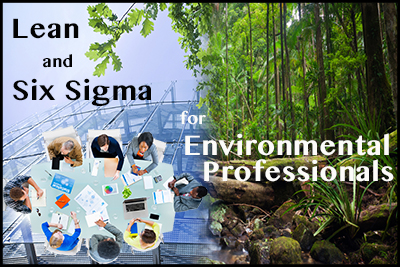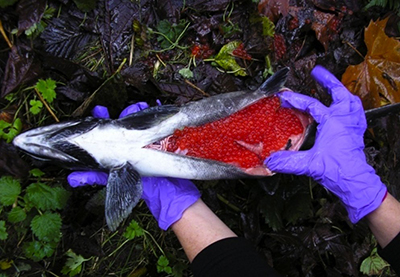Blog
EPA Driving Improvement Methodology Into Government Organizations

-The following is a post by Lean-Six Sigma for Environmental Professionals instructor Brion Hurley. Brion is presenting a live webinar series starting on January 20, 2015.
EPA driving improvement methodology into government organizations
By Brion Hurley, Principal Lean Consultant, Rockwell Collins
Process improvement initiatives began with private corporations in the manufacturing sector, such as Ford, Toyota and Bell Lab. Over the decades, these approaches have matured with the help of companies like General Electric and Motorola. These initiatives carried different names, such as Total Quality Management, Lean, Six Sigma, Lean Six Sigma, and Continuous Improvement (just to name a few). The results have been impressive, with savings of billions of dollars from massive reductions in cycle times, defects and customer complaints. In addition, these companies report higher employee engagement and satisfaction at their jobs.
However, most people do not work for private manufacturing corporations. That only accounts for 10% of all employment in the United States (http://www.bls.gov/emp/ep_table_201.htm). Most employment occurs in the service industry (around 80%), driven by retail, business services, health care, hospitality and government. In fact, these sectors are each about the same size as the manufacturing sector.
What improvement methodology are they using?
The Environmental Protection Agency (EPA) had the same question a few years ago.
Since the mid-2000’s, it has been collecting case studies and examples of public sector organizations implementing Lean and Six Sigma techniques, specifically those in government organizations. From the City of Fort Wayne, Indiana, to the U.S. Mint, to all branches of the U.S. Armed Forces, they have found evidence that proves that government organizations can apply these concepts and get the same results as manufacturing companies. They deployed these techniques within the EPA, and as expected, found similar success stories.
Here are a few examples of service organizations deploying Lean and Six Sigma:
JEA Utilities in Jacksonville, Florida
JEA launched a Lean Six Sigma project to reduce workplace accidents and reduce time to complete maintenance. They implemented a 5S program to organize and standardize the materials on the trucks. These efforts reduced fuel costs by an estimated 10% per truck due to the lighter weight.
Full case study: http://www.epa.gov/lean/environment/studies/jea.pdf
City of Palm Bay, Florida
Palm Bay Utilities prioritized its improvement effort using Lean and Six Sigma to reduce energy costs in its water and wastewater treatment plant operations by 34% from 2008 to 2011. They used 5S+S (5S plus Safety) and completed over 100 improvement events. These efforts saved $1.15 million in FY 2011, and helped the utility to improve its municipal bond ratings in 2009 (Standard and Poor’s) and 2010 (Moody’s).
Full case study: http://epa.gov/lean/environment/pdf/eum-lean-guide.pdf
City of Tyler, Texas
The wastewater department stabilized magnesium hydroxide dosages, which led to reduced costs based on confidence derived from statistical analysis. The analysis showed that they will still comply with state regulations, resulting in $80K in savings to date. They also established standard operating procedures, which ensured the continued efficiency of their process and savings for the city and taxpayers.
Full case study: http://www.minitab.com/en-us/case-studies/City-of-Tyler-Texas/
Iowa Department of Natural Resources
The Iowa DNR conducted over 30 Lean kaizen rapid improvement events. The results include decreasing lead times on underground storage tank correction action decisions from 38 months to 3 months, and reducing the average time to issue standard air construction permits from 62 to 6 days.
Full case study: http://www.epa.gov/lean/government/state-initiatives/iowa-business.htm
Connecticut Department of Energy and Environment Protection
Connecticut DEEP program has undertaken approximately 50 projects to address environmental quality, conservation and business administration processes. The Office of Long Island Sound Permit Program was able to reduce processing time of initial response letter by 85%, from an average of 205 days to 30 days. They were also able to reduce processing time from application receipt to permit decision by 72%, from an average of 566 days to 160 days.
More examples from DEEP: http://www.ct.gov/deep/cwp/view.asp?a=2699&Q=455468&deepNav_GID=1511
To learn more about efforts from the EPA to drive Lean, visit their website at http://epa.gov/lean/government/
That sounds good, but what actual techniques are used to obtain these improvements?
There are many different tools and techniques taught with Lean and Six Sigma initiatives, depending on the type of problem. Some are very simple, like Is/Is-Not, check sheets, pictograms, brainstorming and shadow boards. Others are more complicated, such as Analysis of Variance (ANOVA), Statistical Process Control (SPC) and Heijunka. We could spend an entire article on each tool, so to get started, let’s look at some key themes that help make these initiatives successful.
In order to explain why they work, we need to think about how things work in organizations that do not use these approaches. In many departments and organizations, when a problem comes up, a manager will often get upset at an individual for making a mistake. They will then quickly offer a solution, expect that the solution will get implemented immediately without discussion, and then expect that the problem will never happen again. This is the worst approach to take. The manager has just instilled a fear of reporting problems, blamed the employee (not the process), and their solution will probably not be effective. In fact, all future problems will now be the responsibility of the manager to solve, as the workers are now afraid of making another mistake by trying to solve the problem on their own (and getting the “wrong” answer).
Now let’s look at how Lean and Six Sigma initiatives approach problems differently.
- Disciplined problem solving approach
To consistently solve problems, a company needs to have a common approach, so everyone does it the same way. Problems need to be solved by a cross-functional team of people, not just an individual. Processes work as part of a system, and are not isolated on their own. Only a team can look at the problem from different perspectives and get to the best solution. At each stage of the problem solving process, useful tools and techniques are applied (such as 5 Why’s, Fishbone Diagram, Pareto charts and Brainstorming). This disciplined approach helps communicate how much progress has been made, and gives the team the best chance of success (making it less likely they will skip steps or jump ahead).
- Understand the process
Lean and Six Sigma teaches a thorough evaluation of the current process through physical visits to the work area (or virtual visits if an electronic process), documenting the process graphically, and capturing data on how the process performs. Only when a true understanding of the existing process is clear to the team can effective improvements be implemented. In addition, the idea that processes do not take place in isolation is reinforced. Processes work within a system. If all processes do not work together in an organization for a common goal (customer needs), then the processes can unintentionally cause problems for other departments, workers or even the customer, which cause increased costs, unhappy customers and long delays.
- Focused events
Instead of working on a problem in short tasks that can span months and months, Lean and Six Sigma teaches focused efforts to resolve a problem in a short period of time. Once you decide the problem is worth solving, then get the right people in the room together, talk through the problem, analyze the process, come up with the best solution for the customer, and implement the solution. This can be done in a matter of days, instead of months (or years). The event forces the team to complete the improvements in a certain timeframe (often 3 to 5 full days), with lofty goals (50-90% improvement). This creates a sense of urgency for the team, which keeps distractions to a minimum, and can generate amazing solutions.
- Respect the worker
Possibly the most important factor in how successful these initiatives become will depend on how well the worker is treated. Lean and Six Sigma empowers workers to help solve their own problems, not wait for a manager or support person to tell them how to fix it. Within the problem solving approach and during events, the worker is the expert, not the manager (who does not do the job every day). In many organizations, the employee is given broken processes with conflicting goals, and expected to excel. Lean and Six Sigma focuses on fixing the process first, so the worker has the best chance of success.
If you work in an organization that does not have an improvement initiative, don’t worry. You can pilot this approach within your own department or work area. Start by implementing the four key items above, and make sure you document and share your results with others in your organization.
If you’d like to learn more about Lean and Six Sigma, and how it can improve sustainability, government organizations, or your business, read about the upcoming online course titled “Lean Six Sigma for Environmental Professionals.” There will be two 6-hour courses, “Introduction to Process Improvement” and “Lean Six Sigma Tools.” Each course will be 2 hours per day, held over 3 consecutive days.
Headlines
The City of Portland, Oregon invites applications for the position of Site Development Inspector I
CITY OF PORTLAND invites applications for the position of:
Site Development Inspector I
The City of Portland, Oregon invites applications for the position of Site Development Inspector I
CITY OF PORTLAND invites applications for the position of:
Site Development Inspector I
*Follow NWETC on twitter, and "like" us on Facebook by clicking the icons:
© 2026 NWETC. All rights reserved








